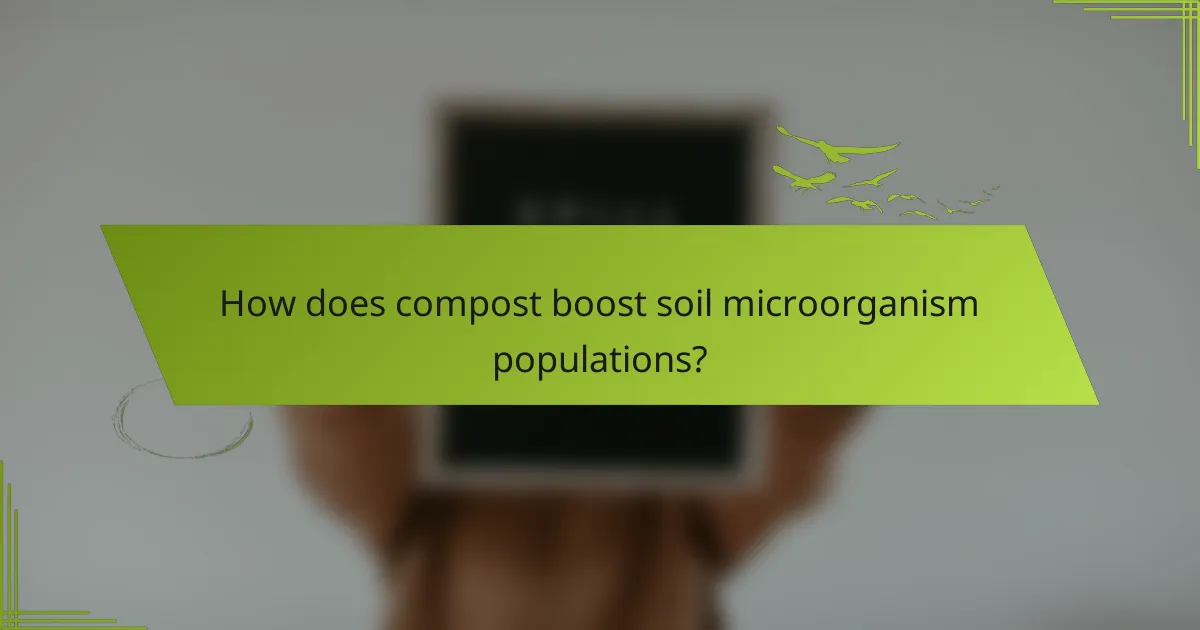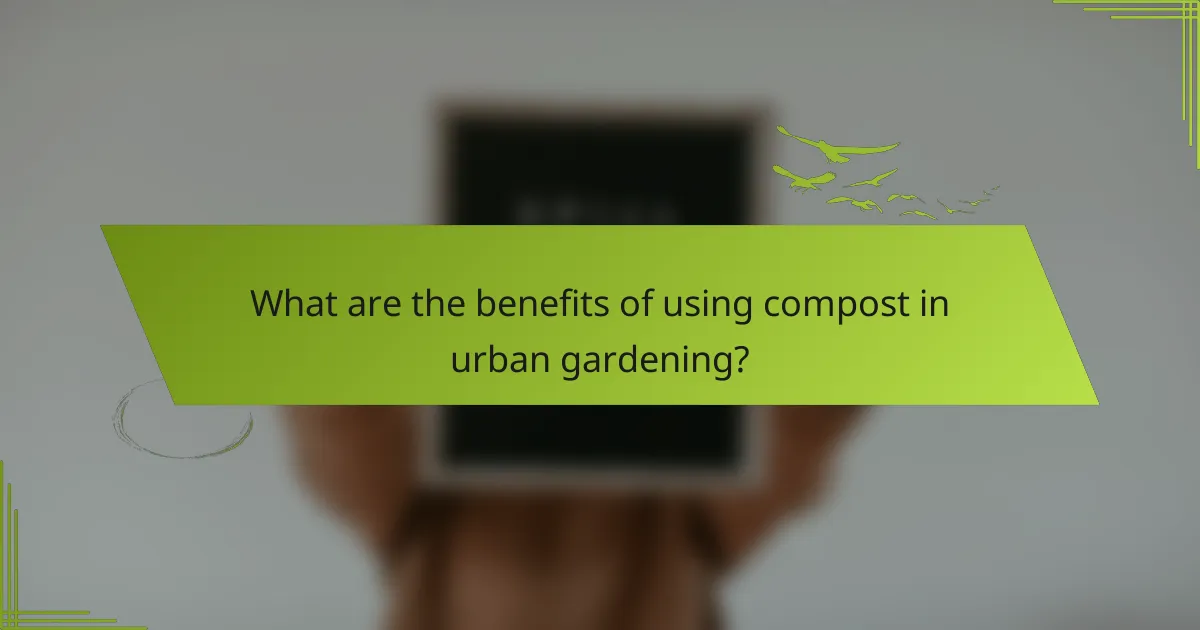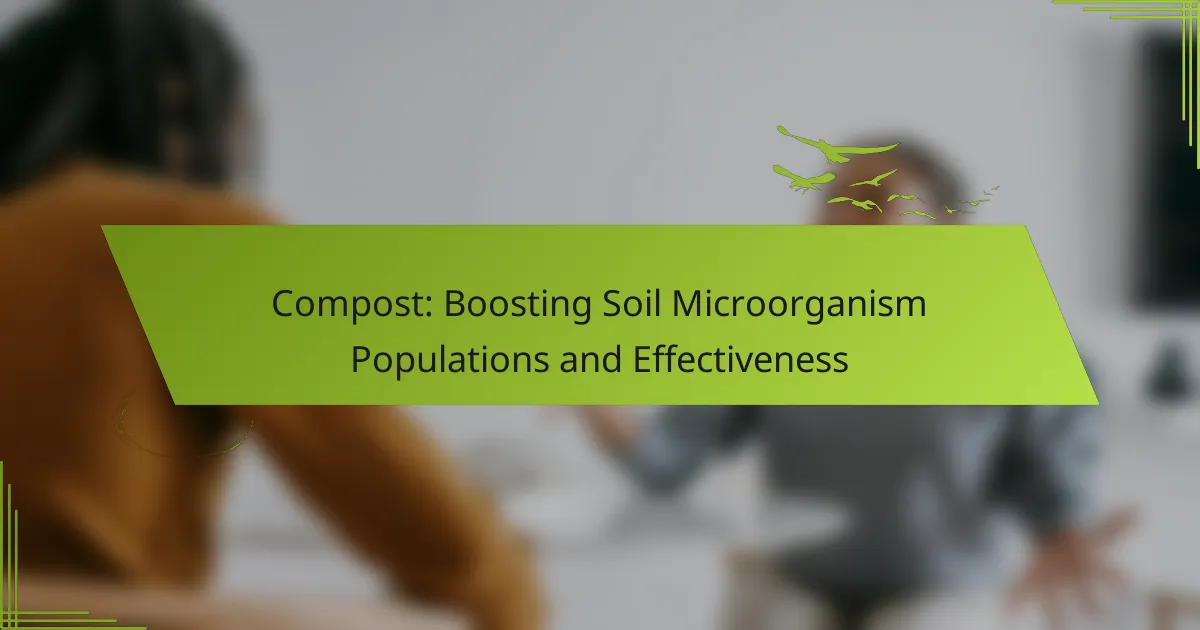Compost plays a vital role in boosting soil microorganism populations by supplying essential nutrients and creating optimal habitat conditions. By enriching the soil with organic matter, compost fosters a diverse microbial community that is crucial for maintaining soil health. Various types of compost, such as organic compost and vermicompost, offer unique benefits that can significantly enhance soil effectiveness.

How does compost boost soil microorganism populations?
Compost enhances soil microorganism populations by providing essential nutrients, improving habitat conditions, and fostering a diverse microbial community. This organic matter enriches the soil, which in turn supports various beneficial microorganisms that play a crucial role in soil health.
Increases nutrient availability
Compost is rich in essential nutrients such as nitrogen, phosphorus, and potassium, which are vital for microbial growth. When added to soil, compost releases these nutrients slowly, making them available to microorganisms over time. This gradual release helps maintain a balanced nutrient supply, promoting a thriving microbial ecosystem.
For effective nutrient availability, aim to incorporate compost at a rate of about 25-30% of the total soil volume. This ensures that microorganisms have enough resources to flourish without overwhelming the soil structure.
Enhances microbial diversity
Compost contributes to microbial diversity by introducing a wide variety of microorganisms, including bacteria, fungi, and protozoa. This diversity is crucial for a resilient soil ecosystem, as different microorganisms perform various functions, such as nutrient cycling and disease suppression.
To maximize microbial diversity, use a mix of compost types, such as kitchen scraps, yard waste, and manure. This variety can help create a more balanced and effective microbial community in the soil.
Improves soil structure
Adding compost improves soil structure by increasing its organic matter content, which enhances aeration and water retention. A well-structured soil allows for better root penetration and microbial activity, creating an ideal environment for microorganisms to thrive.
Incorporating compost can help transform compacted soils into looser, more workable substrates. Aim for regular applications of compost, ideally once or twice a year, to maintain optimal soil structure.
Encourages beneficial bacteria
Compost fosters the growth of beneficial bacteria that play a key role in nutrient cycling and organic matter decomposition. These bacteria help break down complex organic materials into simpler forms that plants can absorb, enhancing overall soil fertility.
To encourage beneficial bacteria, ensure your compost is well-aerated and moist but not waterlogged. This creates an ideal environment for aerobic bacteria, which are more effective at nutrient breakdown than anaerobic counterparts.
Supports fungal growth
Fungi are essential for breaking down organic matter and forming symbiotic relationships with plant roots. Compost provides a habitat rich in organic material that supports various fungal species, which in turn enhances nutrient uptake for plants.
To promote fungal growth, consider adding materials like straw or wood chips to your compost. These carbon-rich inputs can help create a balanced environment that favors fungal development alongside bacteria.

What types of compost are most effective for soil health?
The most effective types of compost for enhancing soil health include organic compost, vermicompost, compost tea, and green manure compost. Each type offers unique benefits and can significantly boost soil microorganism populations, improving overall soil effectiveness.
Organic compost
Organic compost is created from decomposed plant and animal materials, providing a rich source of nutrients for soil. It enhances soil structure, moisture retention, and microbial activity, making it ideal for gardens and farms.
To create organic compost, combine kitchen scraps, yard waste, and other organic materials in a compost bin. Aim for a balanced mix of greens (nitrogen-rich) and browns (carbon-rich) to optimize decomposition. Regularly turning the pile helps aerate it and speed up the composting process.
Vermicompost
Vermicompost is produced through the digestion of organic matter by earthworms, resulting in a nutrient-dense product. It is particularly effective in increasing soil fertility and enhancing microbial populations due to its high levels of beneficial microorganisms.
To produce vermicompost, set up a worm bin with red wigglers and feed them kitchen scraps like vegetable peels and coffee grounds. Maintain moisture and aeration in the bin to ensure healthy worm activity. Vermicompost can be used directly in gardens or mixed into potting soil.
Compost tea
Compost tea is a liquid fertilizer made by steeping compost in water, extracting nutrients and beneficial microbes. It can be used as a foliar spray or soil drench, promoting plant growth and improving soil health.
To brew compost tea, mix well-aged compost with water and let it steep for 24 to 48 hours. Strain the mixture before application to avoid clogging sprayers. Use compost tea within a few days for maximum effectiveness, as its microbial content diminishes over time.
Green manure compost
Green manure compost involves growing specific crops, such as legumes, that are later tilled back into the soil to enrich it. This method enhances soil structure, adds organic matter, and increases nitrogen levels, benefiting subsequent crops.
Choose fast-growing cover crops that suit your climate and soil type. After they mature, till them into the soil before they flower to maximize nutrient release. This practice not only improves soil health but also helps prevent erosion and suppress weeds.

How to apply compost for maximum effectiveness?
To apply compost effectively, consider the method that best suits your soil type and plant needs. Different application techniques can enhance soil microorganism populations and improve overall soil health.
Top dressing application
Top dressing involves spreading a layer of compost on the soil surface around plants. This method allows microorganisms to gradually integrate into the soil while providing nutrients directly to the plants. Aim for a layer of about 1 to 2 inches thick, ensuring it does not smother existing plants.
Regularly top dressing can improve soil structure and moisture retention, making it a practical choice for established gardens. Avoid applying compost too close to plant stems to prevent rot.
Incorporation into soil
Incorporating compost into the soil involves mixing it directly into the top few inches of soil. This method is particularly effective for new garden beds or when preparing soil for planting. Aim to mix in about 20 to 30 percent compost by volume to enhance nutrient availability and microbial activity.
Be cautious not to over-till, as this can disrupt soil structure. Incorporation is best done before planting to allow microorganisms to establish themselves in the soil.
Compost tea spraying
Compost tea is a liquid solution made by steeping compost in water, then straining it for use as a foliar spray. This method delivers beneficial microorganisms directly to plant leaves, promoting health and resilience. Dilute the tea to a ratio of about 1:5 before application.
Spraying compost tea can be particularly useful during the growing season to boost plant vigor. Apply it in the early morning or late afternoon to avoid leaf burn from sunlight.
Layering in garden beds
Layering compost in garden beds involves alternating layers of compost with other organic materials, such as straw or leaves. This method creates a rich, nutrient-dense environment that supports diverse soil microorganisms. Aim for layers of about 2 to 4 inches of compost between other materials.
Layering not only improves soil health but also enhances drainage and aeration. This technique is especially beneficial for new beds, as it builds a robust ecosystem over time.

What are the benefits of using compost in urban gardening?
Compost offers numerous benefits for urban gardening, including improved soil quality, reduced waste, and enhanced plant health. By incorporating compost into your gardening practices, you can create a more sustainable and productive urban environment.
Improves soil fertility
Compost enriches soil fertility by adding essential nutrients and organic matter that enhance soil structure. This leads to better water retention and aeration, which are crucial for healthy root development. Regularly adding compost can significantly increase the nutrient content of urban garden soils.
To maximize soil fertility, aim to incorporate compost at least once or twice a year, particularly before planting seasons. A good rule of thumb is to mix in about 2 to 3 inches of compost into the top 6 to 12 inches of soil.
Reduces waste in landfills
Using compost in urban gardening helps divert organic waste from landfills, which is a significant contributor to greenhouse gas emissions. By composting kitchen scraps and yard waste, urban gardeners can reduce their overall waste footprint while producing a valuable resource for their gardens.
Consider setting up a compost bin or pile in your backyard or community garden. Many cities offer composting programs or workshops to help residents learn how to compost effectively, making it easier to participate in waste reduction efforts.
Enhances plant resilience
Plants grown in compost-enriched soil tend to be more resilient against pests and diseases. The beneficial microorganisms in compost help establish a healthy soil ecosystem that supports plant growth and strengthens their natural defenses.
To enhance plant resilience, mix compost into the soil before planting and continue to apply it as a top dressing during the growing season. This practice not only nourishes the plants but also encourages beneficial microbial activity in the soil.
Supports local biodiversity
Composting contributes to local biodiversity by creating a habitat for various beneficial organisms, such as earthworms and beneficial insects. These organisms play a vital role in maintaining soil health and promoting a balanced ecosystem within urban gardens.
Encouraging biodiversity can be as simple as incorporating a variety of compost materials, including plant clippings, kitchen scraps, and leaves. This diversity in compost ingredients supports a wider range of microorganisms, enhancing the overall health of your garden.

What are the prerequisites for effective composting?
Effective composting requires a balanced approach to materials and conditions. Key factors include maintaining the right carbon-to-nitrogen ratio and controlling moisture levels to optimize microbial activity.
Proper carbon-to-nitrogen ratio
The carbon-to-nitrogen (C:N) ratio is crucial for successful composting, typically ranging from 25:1 to 30:1. Carbon-rich materials, like dried leaves and straw, provide energy, while nitrogen-rich materials, such as grass clippings and kitchen scraps, supply essential nutrients for microorganisms.
To achieve the ideal C:N ratio, mix materials thoughtfully. For instance, if you have a lot of grass clippings, balance them with dry leaves or shredded paper. Regularly check the mixture and adjust as necessary to maintain the proper balance.
Moisture control
Moisture is vital for the composting process, with an optimal level around 40% to 60%. Too much moisture can lead to anaerobic conditions, while too little can slow down decomposition. The compost should feel like a damp sponge—moist but not dripping wet.
To manage moisture, monitor the compost pile regularly. If it feels too dry, add water or moist materials like fruit scraps. Conversely, if it’s too wet, incorporate dry materials to absorb excess moisture and aerate the pile to promote better airflow.
